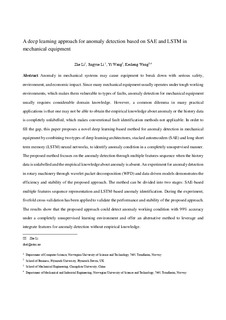| dc.contributor.author | Li, Zhe | |
| dc.contributor.author | Li, Jingyue | |
| dc.contributor.author | Wang, Yi | |
| dc.contributor.author | Wang, Kesheng | |
| dc.date.accessioned | 2019-04-01T08:55:24Z | |
| dc.date.available | 2019-04-01T08:55:24Z | |
| dc.date.created | 2019-03-25T10:06:25Z | |
| dc.date.issued | 2019 | |
| dc.identifier.citation | The International Journal of Advanced Manufacturing Technology. 2019, . | nb_NO |
| dc.identifier.issn | 0268-3768 | |
| dc.identifier.uri | http://hdl.handle.net/11250/2592631 | |
| dc.description.abstract | Anomaly in mechanical systems may cause equipment to break down with serious safety, environment, and economic impact. Since many mechanical equipment usually operates under tough working environments, which makes them vulnerable to types of faults, anomaly detection for mechanical equipment usually requires considerable domain knowledge. However, a common dilemma in many practical applications is that one may not be able to obtain the empirical knowledge about anomaly or the history data is completely unlabelled, which makes conventional fault identification methods are not applicable. In order to fill the gap, this paper proposes a novel deep learning-based method for anomaly detection in mechanical equipment by combining two types of deep learning architectures, Stacked Autoencoders (SAE) and Long Short Term Memory (LSTM) Neural Networks, to identify anomaly condition in a completely unsupervised manner. The proposed method focuses on the anomaly detection through multiple features sequence when the history data is unlabelled and the empirical knowledge about anomaly is absent. An experiment for anomaly detection in rotary machinery through Wavelet Packet Decomposition (WPD) and data-driven models demonstrates the efficiency and stability of the proposed approach. The method can be divided into two stages: SAE-based multiple features sequence representation and LSTM-based anomaly identification. During the experiment, 5-fold cross validation has been applied to validate the performance and stability of the proposed approach. The results show that the proposed approach could detect anomaly working condition with 99% accuracy under a completely unsupervised learning environment and offer an alternative method to leverage and integrate features for anomaly detection without empirical knowledge. | nb_NO |
| dc.language.iso | eng | nb_NO |
| dc.title | A deep learning approach for anomaly detection based on SAE and LSTM in mechanical equipment | nb_NO |
| dc.type | Journal article | nb_NO |
| dc.type | Peer reviewed | nb_NO |
| dc.description.version | acceptedVersion | nb_NO |
| dc.source.pagenumber | 12 | nb_NO |
| dc.source.journal | The International Journal of Advanced Manufacturing Technology | nb_NO |
| dc.identifier.doi | 10.1007/s00170-019-03557-w | |
| dc.identifier.cristin | 1687413 | |
| dc.relation.project | Nordforsk: 83144 | nb_NO |
| dc.description.localcode | Publisher embargo applies until 22 March, 2020 | |
| cristin.unitcode | 194,63,10,0 | |
| cristin.unitcode | 194,64,92,0 | |
| cristin.unitname | Institutt for datateknologi og informatikk | |
| cristin.unitname | Institutt for maskinteknikk og produksjon | |
| cristin.ispublished | true | |
| cristin.fulltext | original | |
| cristin.fulltext | postprint | |
| cristin.qualitycode | 2 | |
